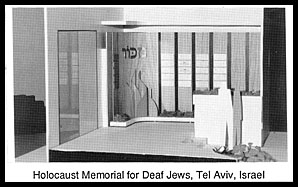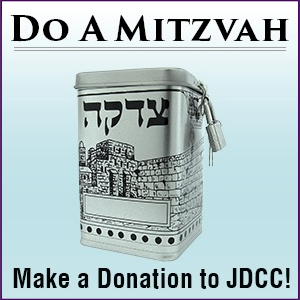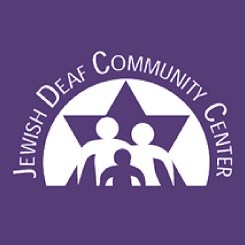This month marks the forty-first anniversary of the Holocaust. History shows that Jewish people have suffered through many tragedies. The Holocaust, however, was the largest single incident. Over six million people were killed, mostly in concentration camps. Not only were Jewish people targeted by the Nazis, but deaf people, in fact, all handicapped people was also on the Nazis’ list. The Nazis believed that certain groups of people including Jewish and handicapped people were “imperfect”. They wanted to create a single race that was “perfect”.
Now that forty one years has passed, we should never forget what has taken place. It is an appropriate time to think of our loved ones who perished and “let us never forget what happened.” Two deaf Holocaust survivors have passed away recently – Joseph Schertz, and Frieda Wurmfeld.
JDCC Preserves History
 On May 22, 1994, JDCC held a Holocaust panel discussion at the Museum of Tolerance. Flyers were designed in shape of the Star of David on yellow paper and mailed to the Los Angeles deaf community. Six deaf people were on the panel and shared their own personal Holocaust experiences.
On May 22, 1994, JDCC held a Holocaust panel discussion at the Museum of Tolerance. Flyers were designed in shape of the Star of David on yellow paper and mailed to the Los Angeles deaf community. Six deaf people were on the panel and shared their own personal Holocaust experiences.
JDCC sponsored this event because awareness of the Holocaust has increased and deaf people, as well as our future deaf generations, also needed to hear the experiences of deaf Holocaust survivors and those who died.
The Museum of Tolerance made our 1994 event possible by giving us meeting space for panelists and a ‘mini-museum’. The six panelists were: Rose Feld Rosman, Lotte Friedman, Marion Intrator, Harry Dunai, and Hetty & Ira Rothenberg. There were over 100 participants.
What’s Happening Elsewhere
Horst Biesold spoke about his research with Jewish and non-Jewish deaf survivors of Nazi crimes at a convention of the World Organization of Jewish Deaf held in Jerusalem in 1981.
It was through that lecture that Marla Petal, a hearing Jewish social worker in Los Angeles familiar with sign language, first learned about deaf victims and survivors of the Holocaust. When she became Community Program Coordinator for Temple Beth Solomon of the Deaf in Arleta, CA, she met some Holocaust survivors. Slowly, and informally, people began sharing their personal experiences.
Knowing that the Jewish community has annual programs to remember victims of the Holocaust, she wanted to develop a program to remember deaf victims as well.
Going Back In History
At the second convention of the National Congress of Jewish Deaf held in Atlantic City, New Jersey in 1958, Simon Carmel met a deaf couple from Philadelphia, Solomon and Regina Goldfinger who immigrated from Poland. They told Carmel they were in a concentration camp. Carmel was stunned, as he had never realized that deaf Jews were also being confined or killed in the camps during the war.
It was due to that conversation that Carmel became very involved in this issue. Since 1980, Carmel has been collecting stories and developing folklore.
First Public Workshop
In 1982, during the National Congress of Jewish Deaf biennial convention in Washington, D.C., Carmel moderated a workshop ‘Jewish Deaf Folklore’. After the discussion, Carmel gently asked deaf holocaust survivors to share their experiences. “It is important that survivors share their stories”, Carmel emphasized, “because Jewish hearing and deaf people have overlooked their horrible experiences in the camps, while other hearing survivors have already testified on films, videotapes and also in published manuscripts and books for years.”
Magda Zimet and her husband Lazslo Bardos came to the platform and spoke briefly. We believe this was the first public dialogue on this subject.
Tried To Write Script
Gregg Brooks wrote a script in 1982 based on Rose Steinberg Feld’s experience. Steinberg Feld, a Los Angeles, CA resident, was a deaf victim of the holocaust. Brooks had hoped to develop a play, but was not successful.
Traveling Holocaust Exhibit
 Marla Petal and Michelle Baron, however, developed an exhibit on Rose Feld Rosman’s story in 1983. This project, called ‘Crying Hands: Deaf Victims of the Holocaust’, traveled to three cities in the U.S. Professor Horst Biesold gave a slide show of the old Israelite Institute for the Deaf in East Berlin in 1933 and showed a simple plaque on the same building, inscribed in German, “From this house 146 deaf Jewish citizens were dragged by fascist bandits and murdered in 1942. A memorial to the dead. A reminder for the living.”
Marla Petal and Michelle Baron, however, developed an exhibit on Rose Feld Rosman’s story in 1983. This project, called ‘Crying Hands: Deaf Victims of the Holocaust’, traveled to three cities in the U.S. Professor Horst Biesold gave a slide show of the old Israelite Institute for the Deaf in East Berlin in 1933 and showed a simple plaque on the same building, inscribed in German, “From this house 146 deaf Jewish citizens were dragged by fascist bandits and murdered in 1942. A memorial to the dead. A reminder for the living.”
Professor Biesold lobbied for a law through the German Bundestag who agreed to grant compensation of $2,000.00 for each deaf Survivor. There was a panel of three people who shared their experiences: Rose Steinberg Feld, Magda Carmel, and Marion Intrator. It was presented at Temple Beth Solomon on April 24, in Washington, D.C. on May 1st, and New York City on May 4th.
Television Exposure
Herb Larson, host of ‘Off Hand’, a TV production of the Silent Network, interviewed deaf survivors, Marion Intrator, Rose Feld Rosman, and Lotte Friedman on one show in 1983. This program was broadcast on a local Los Angeles TV station and nationally over the Silent Network Satellite Service.
Marla Petal & Michelle Baron of All the People were curators of another exhibit. With help of grants and contributions, they developed a photo-narrative display based on the story of Rose Steinberg and her husband, Max Feld. It was shown at the University of California, Los Angeles (UCLA) during the 1985 Summer World Games for the Deaf, and premiered at the Martyrs Memorial and Museum of the Holocaust at the Jewish Federation Building in Los Angeles.
Deaf Mosaic, a monthly Gallaudet University TV show, also interviewed Stanley Teger about his experience during the Holocaust. This 30-minute show, Film #309, Show Date November 25, 1987, is presented in sign language with open captions and is still available for purchase through Gallaudet University.
Day Of Holocaust Remembrance
Gallaudet University, the Department of College for Continuing Education co-sponsored, along with District of Columbia Jewish Community Center, National Congress of Jewish Deaf, and Washington Society of Jewish Deaf a program, ‘In Der Nacht’ from April 19 to May 17, 1988 on the Gallaudet campus. Following an opening reception, the program observed Yom Hashoa – The Day of Holocaust Remembrance. This program was also held in the Senate Rotunda at the U.S. Capitol in May, 1988, and has travelled across the country.
Professor Biesold
Professor Horst Biesold is a former teacher of the deaf. Why did he begin his research? He had noticed that many people in the deaf community did not any have children, and asked a friend about it.
Professor Biesold said that “He looked anxious, sad”. The friend took him to a separate room and made two signs that he didn’t recognize. “I said, ‘What’s that?'”, Professor Biesold asked. And the answer was, “Sterilized by force.”
The Professor was astonished. He had never heard of this before, and that was the beginning of his work. He discovered, after years of research, that at least 17,000 deaf Germans had been sterilized, and it was kept secret. The Nazi government had told the victims “You don’t speak to anyone. If you speak to anyone about your sterilization, you have to go into the concentration camp…. they are ashamed about their fate, that they can’t have children.”
Biesold said he later came to realize that many of his teachers, and teachers in schools for deaf people, had been Nazis who did not want to reveal the things they or their parents had done. But now there is a new generation in Germany, and they want to know.
Deaf Holocaust Artworks
 There are two deaf artists that produced works on holocaust as related to deafness. David Ludwig Bloch, a deaf holocaust survivor was arrested and incarcerated at Dachau. Upon his retirement in 1975 in Mt. Vernon, NY, Bloch drew pictures of his holocaust images in paintings and woodcuts format. His works have been displayed across the country. His artworks are powerful and emotional. Examples of his works: Knock at Midnight, The Last Stop, Reception/Deception, The Empty Box (Angel of Death), and Crying Hand. See photo above.
There are two deaf artists that produced works on holocaust as related to deafness. David Ludwig Bloch, a deaf holocaust survivor was arrested and incarcerated at Dachau. Upon his retirement in 1975 in Mt. Vernon, NY, Bloch drew pictures of his holocaust images in paintings and woodcuts format. His works have been displayed across the country. His artworks are powerful and emotional. Examples of his works: Knock at Midnight, The Last Stop, Reception/Deception, The Empty Box (Angel of Death), and Crying Hand. See photo above.
Another deaf artist, Morris Broderson, a well-known deaf painter in Los Angeles, CA. was so moved after reading the Diary of Anne Frank, he painted two pictures of her in 1970. One picture shows Anne Frank with her diary, and the other is a picture of a calendar with fingerspelling of her name.
Special Projects
A television program called, “Hey Listen,” with hostess Jackie Schertz interviewed David Bloch and Stanley Teger. ‘Deaf Holocaust Survivors’ in April, 1989. This TV program is 60 minutes long and available only in sign language with voice over.
During the 1990 National Congress of Jewish Deaf’s convention at Meadowlands Inn, New Jersey, Carmel moderated another panel of four deaf holocaust survivors, Rose Steinberg Feld, Stanley Teger, Frieda Wurmfeld, and David Bloch.
Carmel also helped to organize ‘Insights from the Holocaust Experience: Deaf and Hearing Survivors’, a program held at National Technical Institute for the Deaf in Rochester, New York in April 1989. Three deaf survivors, Frieda Wurmfeld, David Bloch, and Stanley Teger all shared their stories.
146 taubltumme judilche
Milburger 1942 durch
falchilfilche Bandrlen
verichleppf und ermordef
Den Toten zum Gedenken
den Lebendenzur Mahnong
A PLAQUE IN EAST BERLIN
is all that remains of the Hebrew Institute for Deaf-
_____________________________________________
The school’s headmaster Dr. Felix Reich, along with 11 students, Marion Schlessinger Intrator (CA), Hennie Sonntag (NY), Horst Marschner who was the oldest at 12 years old (GERMANY), Annie Marschner Senchel (ENGLAND), Klaus Silberman (ENGLAND), Lothar Bibier, the youngest at 3 years old (ENGLAND), Ruth Danzinger Fallman (ENGLAND), Hans Schwartz (ISRAEL) & three others unknown had fled to England three years earlier.
Memorial For Deaf In Israel
The Holocaust Memorial for Deaf Jews was established at the Helen Keller Center in Tel Aviv, Israel in January, 1991. This Memorial was set up to honor the memory of the six thousand deaf Jews who perished in the Holocaust. The first donation made in 1989 to help start this Memorial was made by the German government. Mr. Ernst Walthemathe, a member of the Bundestag initiated this. The memorial includes a small sculpture and a wall listing the names of outstanding personalities and leaders, friends and family members who lost their lives in the Holocaust.
Chaim Herzog, president of Israel at that time, wrote “The erection of the “Yizkor” site in the Helen Keller Center, in memory of the thousands of deaf Jews, murdered by the Nazis is a very important initiative to all those, who perished in this terrible Holocaust, whose noise they did not hear, but whose blood streamed in the rivers of blood of their communities.”
Covered In A Book
At a symposium held at Rochester Institute of Technology, New York called, “Historical Perspectives: Deaf People in the Holocaust,” author Ina B. Friedman, who was researching the Holocaust for her first book ‘Escape or Die: True Stories of Young People Who Escaped from the Nazis’, wondered why the lesser-known stories were not told. In research of her second book, Ina traveled to Munich, Germany and interviewed a woman named, Franziska (Fanny) Schwarz who was deaf and devoted a chapter on her in the second book, ‘The Other Victims, First-Person Stories of Non-Jews Persecuted by the Nazis in 1990.’
After Friedman’s speech in April, 1991, a panel discussion was held with Simon Carmel, and Stanley Teger.
In 1993, the Rochester Institute School for the Deaf in New York had a play based on the story of Meta Noveck’s experience.
The Future?
Carmel continues to videotape interviews with survivors. Sad to say, there are now very few deaf survivors in the U.S., Europe and Israel. Carmel needs volunteers to immediately collect stories from them or their children and friends who have listened to their testimonies before the survivors die.
The Holocaust Museum in Washington, D.C. contacted Donna Ryan, an European Specialist and consultant in the area of French Resistance during the war for assistance. Ryan turned to John Schuchman, a Gallaudet University professor who had been videotaping oral history interviews with deaf people since 1981. Their first task is to try and get a sense of the number of people out there. They are going to do research and study what the Nazi doctors, school, teachers and school administration were doing and saying in the 1920’s and 1930’s.
Once they have compiled the story, they plan to start interviewing survivors. Schuchman explains that literature is fairly clear that the views held by doctors, basically eugenics views, preceded the Nazis – Hitler – coming to power in 1933, and that medical people were what we now call collaborators. He believes that something similar happened with the schools both in Germany and here in U.S.
Marla Petal also plans to put stories on the history of the Israelite School for the Deaf, life stories of several deaf survivors, and the eugenics movement in the form of a curriculum on CD-ROM. The advantage of CD-ROM, which runs on computers, is that it can also include photographs, some video with sound and written words.
Petal, together with Michelle Baron, have already spent nine years trying to bring the history of deaf victims and survivors of the Holocaust to more people. They are continuing to try to interest people in Hollywood about possibly making a TV movie or film based on Rose Feld Rosman’s life story.
Printed Materials
It appears that one of the earliest print media form that mentions the deaf Holocaust experience was ‘Let Us Not Forget’, written by Stanley Teger’s mother in 1974. It chronicled the family’s experiences during the war.
The following deaf publications have also printed articles on deaf-related Holocaust experiences:
- Silent News, 1979, David Bloch
- The Deaf American Vol. 35, No. 3, 1982, Ellen Beck, “Eugene Bergman: Deaf Survivor”
- The Deaf American Vol. 35, No. 8, 1983, Ernest Gill, “Horst Beisold: Helping the Survivors”
- Silent News, May 1984, Robert Swain, Deaf Profile: A Mother’s Courage Defied the Nazis
- Gallaudet Today, Winter, 1987-88, Vickie Walter, “Inside the Madness,” and “In Der Nacht”
- VOICE Vol. 4, No. 4 May/June 1988, Steve C. Baldwin, “Genocide and Deafness”
- NTID Focus, Fall 1989, Lynne Bohlman, “Deaf Holocaust Survivors Tell Their Stories”
- Temple Beth Solomon for the Deaf, Congregation News, November, 1992 Lotte Friedman, “I Return to the Place of My Birth”
- Washington Society of Jewish Deaf Newsletter, Volume 17, No. 5, August 1993, Lilly R. Shirey, “Pre-Holocaust Experience with a Jewish Deaf Family”
Other Publications
- Heritage, Southwest Jewish Press, May 13, 1983 Tom Tugend, “Deaf Were Special Victims of the Nazis”
- Gannett Westchester Rockland Newspapers (NY), Sunday, September 20, 1987, Suburban PEOPLE, David Bloch: “An Artist’s unforgettable message”
- The Jewish Standard (NJ), August 17, 1990 Ronnie Levine, “Deaf Survivors’ stories told at last”




